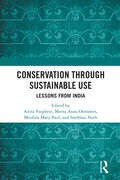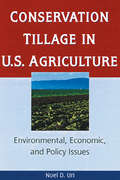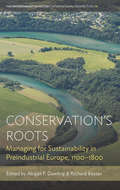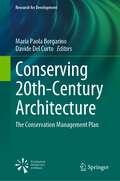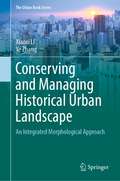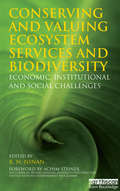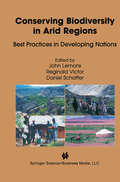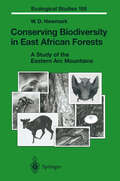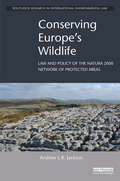- Table View
- List View
Conservation through Sustainable Use: Lessons from India
by Anita Varghese Meera Anna Oommen Mridula Mary Paul Snehlata NathThe human use of nature is a polarizing topic in India and across the globe, often perceived as contradictory to traditional exclusionary conservation. However, India’s natural landscapes serve as important sources of biological resources for many communities. This collection of case studies on sustainable use practices throughout India aims to identify the policies, management strategies, and knowledge contexts that contribute to resource use without damaging biological diversity. Through a diverse array of personal accounts, stories and photographs from the field, and ongoing research studies across biogeographic zones, readers will connect with academics, practitioners, managers, and policy analysts who challenge us to rethink the conservation paradigm. These chapters provide a reflection on the history of conservation and sustainable use in India and illuminate a path towards a local and global future in which biodiversity and human well-being go hand in hand. The wide variety of authors in this book reflects the broad audience this book will be of interest to, from students studying environmental conservation and sustainability to researchers, practitioners, and policymakers who work in the field and seek to learn about successful sustainable use systems and resulting lessons that have widespread application. This book will appeal to readers interested in the areas of environment sciences, biodiversity management, sustainable development, developmental studies, forestry, wildlife and protected area management, public policy, environmental policy, and governance.
Conservation through Sustainable Use: Lessons from India
by Anita Varghese Meera Anna Oommen Mridula Mary Paul Snehlata NathThe human use of nature is a polarizing topic in India and across the globe, often perceived as contradictory to traditional exclusionary conservation. However, India’s natural landscapes serve as important sources of biological resources for many communities. This collection of case studies on sustainable use practices throughout India aims to identify the policies, management strategies, and knowledge contexts that contribute to resource use without damaging biological diversity. Through a diverse array of personal accounts, stories and photographs from the field, and ongoing research studies across biogeographic zones, readers will connect with academics, practitioners, managers, and policy analysts who challenge us to rethink the conservation paradigm. These chapters provide a reflection on the history of conservation and sustainable use in India and illuminate a path towards a local and global future in which biodiversity and human well-being go hand in hand. The wide variety of authors in this book reflects the broad audience this book will be of interest to, from students studying environmental conservation and sustainability to researchers, practitioners, and policymakers who work in the field and seek to learn about successful sustainable use systems and resulting lessons that have widespread application. This book will appeal to readers interested in the areas of environment sciences, biodiversity management, sustainable development, developmental studies, forestry, wildlife and protected area management, public policy, environmental policy, and governance.
Conservation Tillage and Cropping Innovation: Constructing the New Culture of Agriculture
by C. Milton Coughenour Shankariah ChamalaA sociological study of changing farming methods, Conservation Tillage and Cropping Innovation investigates those techniques that have gradually continued to replace the plow culture. With thorough documentation of the conservation tillage and cropping revolution, this book features chapters on: The Social Construction of Innovative Networks; Planning Conservation Cropping: Implications for Research, Development, and Extension; The New Agriculture of Conservation Cropping: Present and Future.
Conservation Tillage in U.S. Agriculture: Environmental, Economic, and Policy Issues
by Noel UriDiscover farming techniques that will decrease soil erosion and costs!Soil erosion from U.S. croplands has long been recognized as a national problem. Conservation Tillage in U.S. Agriculture: Environmental, Economic, and Policy Issues is the first ever complete study of the costs and benefits of using conservation tillage to prevent soil erosion. Designed for professionals working in the areas of soil science, agronomy, economics, environmental studies, and agriculture, this complete study covers everything from machinery and trends in conservation tillage to its adoption to use in regions of the United States.With this in-depth manual, you will examine different types of tillage and the many benefits this practice can ensure, such as improving water quality, increasing organic matter in your soil, sequestering carbon, and providing habitat and food for wildlife. Covering the economic, environmental, and policy issues of this practice, Conservation Tillage in U.S. Agriculture features: the history of conservation tillage case studies on costs and benefits of differing conservation tillage practices with various crops tables and graphs of trends, and case studies concerning the use of different farming methods U.S. Department of Agriculture soil conservation policies how to prevent soil erosion without harming the environment factors affecting conservation tillage, adoption, and use for crops such as peanuts, potatoes, beets, tobacco, and vegetables. With the help of this book, you will measure the benefits and costs of conservation tillage based on profitability and environmental impact and explore the positive and negative environmental consequences that may involve air, land, water, and/or the health and ecological status of wildlife. Conservation Tillage in U.S. Agriculture is a timely and informative look at conservation tillage practices that will help you improve residue management and create better conditions for wildlife and the environment.
Conservation Tillage in U.S. Agriculture: Environmental, Economic, and Policy Issues
by Noel UriDiscover farming techniques that will decrease soil erosion and costs!Soil erosion from U.S. croplands has long been recognized as a national problem. Conservation Tillage in U.S. Agriculture: Environmental, Economic, and Policy Issues is the first ever complete study of the costs and benefits of using conservation tillage to prevent soil erosion. Designed for professionals working in the areas of soil science, agronomy, economics, environmental studies, and agriculture, this complete study covers everything from machinery and trends in conservation tillage to its adoption to use in regions of the United States.With this in-depth manual, you will examine different types of tillage and the many benefits this practice can ensure, such as improving water quality, increasing organic matter in your soil, sequestering carbon, and providing habitat and food for wildlife. Covering the economic, environmental, and policy issues of this practice, Conservation Tillage in U.S. Agriculture features: the history of conservation tillage case studies on costs and benefits of differing conservation tillage practices with various crops tables and graphs of trends, and case studies concerning the use of different farming methods U.S. Department of Agriculture soil conservation policies how to prevent soil erosion without harming the environment factors affecting conservation tillage, adoption, and use for crops such as peanuts, potatoes, beets, tobacco, and vegetables. With the help of this book, you will measure the benefits and costs of conservation tillage based on profitability and environmental impact and explore the positive and negative environmental consequences that may involve air, land, water, and/or the health and ecological status of wildlife. Conservation Tillage in U.S. Agriculture is a timely and informative look at conservation tillage practices that will help you improve residue management and create better conditions for wildlife and the environment.
Conservation’s Roots: Managing for Sustainability in Preindustrial Europe, 1100–1800 (Environment in History: International Perspectives #19)
by Abigail P. Dowling Richard KeyserThe ideas and practices that comprise “conservation” are often assumed to have arisen within the last two centuries. However, while conservation today has been undeniably entwined with processes of modernity, its historical roots run much deeper. Considering a variety of preindustrial European settings, this book assembles case studies from the medieval and early modern eras to demonstrate that practices like those advocated by modern conservationists were far more widespread and intentional than is widely acknowledged. As the first book-length treatment of the subject, Conservation’s Roots provides broad social, historical, and environmental context for the emergence of the nineteenth-century conservation movement.
Conservative Margin (large print)
by RnibThis page consists of aerial views of two types of conservative margins, both with dashed image borders. There is a locator dot shown, which will be at the top left of the page when the image is the right way up. The diagram on the left shows two adjacent plates moving in opposite directions as indicated by arrows. The plate to the left of the diagram is moving towards the top of the page, while the plate on the right is moving towards the bottom. The scraping and snagging of the plates causes powerful earthquakes. The diagram on the right of the page shows two plates moving in the same direction. The plate on the right is moving faster than the one on the left, which is again causing scraping and snagging.
Conservative Margin (tactile)
by RnibThis page consists of aerial views of two types of conservative margins, both with dashed image borders. There is a locator dot shown, which will be at the top left of the page when the image is the right way up. The diagram on the left shows two adjacent plates moving in opposite directions as indicated by arrows. The plate to the left of the diagram is moving towards the top of the page, while the plate on the right is moving towards the bottom. The scraping and snagging of the plates causes powerful earthquakes. The diagram on the right of the page shows two plates moving in the same direction. The plate on the right is moving faster than the one on the left, which is again causing scraping and snagging.
Conservative Realizations of Herglotz-Nevanlinna Functions (Operator Theory: Advances and Applications #217)
by Yuri Arlinskii Sergey Belyi Eduard TsekanovskiiThis book is devoted to conservative realizations of various classes of Stieltjes, inverse Stieltjes, and general Herglotz-Nevanlinna functions as impedance functions of linear systems. The main feature of the monograph is a new approach to the realization theory profoundly involving developed extension theory in triplets of rigged Hilbert spaces and unbounded operators as state-space operators of linear systems. The connections of the realization theory to systems with accretive, sectorial, and contractive state-space operators as well as to the Phillips-Kato sectorial extension problem, the Krein-von Neumann and Friedrichs extremal extensions are provided. Among other results the book contains applications to the inverse problems for linear systems with non-self-adjoint Schrödinger operators, Jacobi matrices, and to the Nevanlinna-Pick system interpolation.
Conserving 20th-Century Architecture: The Conservation Management Plan (Research for Development)
by Maria Paola Borgarino Davide Del CurtoThis book offers an international overview of how to apply the Conservation Management Plan (CMP) to the 20th-century architectural heritage. Although the CMP is universally considered a fundamental tool for sustainable management of the built heritage, the application to 20th-century buildings is still limited. The book illustrates selected case studies from different countries to discuss how best to preserve the authenticity of the original materials, manage changes in use, engage users and stakeholders in this process, and make conservation and sustainability work together. "Conserving 20th-century architecture" will provide insights for scholars and students and assist architects in drafting an effective conservation management plan.
Conserving and Managing Historical Urban Landscape: An Integrated Morphological Approach (The Urban Book Series)
by Xiaoxi Li Ye ZhangThis book focuses on urban morphology and its application to urban conservation and management. The rapid disappearance of historical urban landscapes, especially in developing countries, is largely attributed to the lack of historic awareness and broad-brush demolition and redevelopment in urban development. The book provides a new, integrated morphological approach that enables fine-grained and cross-scale examination of urban form based on both its historicity and socio-economic potential, with the aims of informing more responsive and context-specific conservation and management of historical urban landscapes. The robustness of this new approach and the feasibility of its application to urban conservation practice are tested and demonstrated by three case studies in drastically different cultural contexts, namely Ludlow, a medieval town in the UK, Chinatown in Singapore and a historic quarter in Nanjing, China. Combining historico-geographical and configurational approaches, the book also makes a significant breakthrough in terms of coordinating and synthesizing different traditions of urban morphology, which has been a key challenge to this field over the past decades. In addition, by using multi-source data, ranging from conventional cartographic maps to computer-generated and open online data, the integrated approach innovatively relates qualitative and quantitative aspects of urban form and links the qualitative and quantitative analyses of formal structure. As an interdisciplinary study merging geography, urban history, urban planning and design, this book is to be primarily used as a reference book for graduate students and scholars in various fields who are interested in urban form and urban conservation and management. In addition, it offers practitioners in urban planning and design a useful tool for managing changes in historical urban landscapes. Lastly, it contributes to developing a common platform to facilitate dialogues among various stakeholders and participants in urban conservation practice.
Conserving and Valuing Ecosystem Services and Biodiversity: Economic, Institutional and Social Challenges
by K. N. NinanThis book comprehensively addresses the economic, social and institutional difficulties in conserving biodiversity and the ecosystem services that it provides. It covers a wide range of issues such as biodiversity, ecosystem services and valuation in the context of diverse ecosystems such as tropical forests, marine areas, wetlands and agricultural landscapes, non-timber forest products, incentives and institutions, payments for ecosystem services, governance, intellectual property rights and the protection of traditional knowledge, management of protected areas, and climate change and biodiversity. It also covers the application of environmental economics and institutional economics to different cases and the use of techniques such as contingent valuation method and game theory. The book spans the globe with case studies drawn from a cross section of regions and continents including the UK, US, Europe, Australia, India, Africa and South America.
Conserving and Valuing Ecosystem Services and Biodiversity: Economic, Institutional and Social Challenges
by K. N. NinanThis book comprehensively addresses the economic, social and institutional difficulties in conserving biodiversity and the ecosystem services that it provides. It covers a wide range of issues such as biodiversity, ecosystem services and valuation in the context of diverse ecosystems such as tropical forests, marine areas, wetlands and agricultural landscapes, non-timber forest products, incentives and institutions, payments for ecosystem services, governance, intellectual property rights and the protection of traditional knowledge, management of protected areas, and climate change and biodiversity. It also covers the application of environmental economics and institutional economics to different cases and the use of techniques such as contingent valuation method and game theory. The book spans the globe with case studies drawn from a cross section of regions and continents including the UK, US, Europe, Australia, India, Africa and South America.
Conserving Biodiversity in Arid Regions: Best Practices in Developing Nations
by John Lemons Reginald Victor Daniel SchafferOn the eve of the World Summit for Sustainable Development (WSSD), held in autumn 2002 in Johannesburg, South Africa, United Nations Secretary General Kofi Annan recommended five specific areas as focal points of discussion for the global forum: Water, energy, health, agriculture and biodiversity. In his address, "Towards a Sustainable Future," delivered just four months before the WSSD, Secretary General Annan contended that concrete progress in each of these areas, often referred to by their acronym WEHAB, would be key to improving the quality of life not only in the developing world but across the globe. For most people, I think it is fair to say that the inclusion of biodiversity in a list that focuses on basic human needs may not be self-evident. Water, energy, health and agriculture, yes. But why biodiversity? The truth is that biodiversity is just as critical to global well-being as water, energy, agriculture and health. This is because biodiversity both drives and shapes nature's intricate and dynamic structure in an enduring form and force that enables both current and future generations to enjoy its bounty.
Conserving Biodiversity in East African Forests: A Study of the Eastern Arc Mountains (Ecological Studies #155)
by W.D. NewmarkTanzania is one of the most biologically diverse nations in the world. Traveling from west to east across Tanzania, one encounters an incredible array of ecosystems and species. Beginning at Lakes Victoria, Tanganyika, and Nyasa that form much of the western boundary of Tanzania, one finds the most diverse and some of the most spectacular concentrations of endemic fish in any of the world's lakes. Moving further inland from the lakes, one meets the woodlands and plains of Serengeti, Ngorongoro, Tarangire, and Lake Manyara. The assemblages and movements of large mammals in these protected areas are unparalleled worldwide. Traveling yet further to the east, one comes to Mount Kilimanjaro, the highest mountain in Africa. Mount Kilimanjaro is of sufficient height to not only contain seven major vegetation zones, but also maintain permanent glaciers. Finally, shortly before arriving at the Indian Ocean, one encounters the Eastern Arc Mountains, a series of isolated and geologically ancient mountains, which due to their height and proximity to the Indian Ocean intercept sufficient precipitation to support, in many areas, moist tropical forest. The Eastern Arc Mountains are among the richest sites biologically in all of Africa and harbor unusually high concentrations of endemic species - species whose geographic distribution are restricted to these mountains. Unfortunately, much of Tanzania's biodiversity is threatened by habitat alteration, destruction, and exploitation. The Eastern Arc forests face some of the most severe threats to any of Tanzania's biologically unique sites.
Conserving Cultural Landscapes: Challenges and New Directions
by Ken Taylor Archer St Clair Nora J. MitchellNew approaches to both cultural landscapes and historic urban landscapes increasingly recognize the need to guide future change, rather than simply protecting the fabric of the past. Challenging traditional notions of historic preservation, Conserving Cultural Landscapes takes a dynamic multifaceted approach to conservation. It builds on the premise that a successful approach to urban and cultural landscape conservation recognizes cultural as well as natural values, sustains traditional connections to place, and engages people in stewardship where they live and work. It brings together academics within the humanities and humanistic social sciences, conservation and preservation professionals, practitioners, and stakeholders to rethink the meaning and practice of cultural heritage conservation, encourage international cooperation, and stimulate collaborative research and scholarship.
Conserving Cultural Landscapes: Challenges and New Directions
by Ken Taylor Nora J. Mitchell Archer St. ClairNew approaches to both cultural landscapes and historic urban landscapes increasingly recognize the need to guide future change, rather than simply protecting the fabric of the past. Challenging traditional notions of historic preservation, Conserving Cultural Landscapes takes a dynamic multifaceted approach to conservation. It builds on the premise that a successful approach to urban and cultural landscape conservation recognizes cultural as well as natural values, sustains traditional connections to place, and engages people in stewardship where they live and work. It brings together academics within the humanities and humanistic social sciences, conservation and preservation professionals, practitioners, and stakeholders to rethink the meaning and practice of cultural heritage conservation, encourage international cooperation, and stimulate collaborative research and scholarship.
Conserving Europe's Wildlife: Law and Policy of the Natura 2000 Network of Protected Areas (Routledge Research in International Environmental Law)
by Andrew L.R. JacksonThe Natura 2000 network of protected areas is the centrepiece of European Union nature policy, currently covering almost one-fifth of the EU’s entire land territory plus large marine areas. This vast EU-wide network, which aims to conserve Europe’s most valuable and threatened species and habitats, has major impacts on land use throughout all Member States of the EU. This book critically assesses the origins and implementation of the Natura 2000 network, established under the Birds Directive of 1979 and the Habitats Directive of 1992. Based on original archival research and interviews with key participants, the book records a detailed history of the origins and negotiation of Natura 2000 policy and law, with the history of EU environmental policy provided as a framework. An historical institutionalist approach is adopted, which emphasises the importance of understanding legal and policy development as processes that unfold over time. Three phases in the history of EU environmental policy are identified and described, and the history of EU nature policy is placed within the context of these three phases. Informed by this history, the author presents a comprehensive summary and assessment of the law and policy that protects Natura 2000 sites at EU level, and reviews the nature conservation outcomes for the targeted species and habitats. The book reveals how a knowledge of the history of Natura 2000 enriches our understanding of key issues such as conflicts in establishing and conserving the Natura 2000 network, EU integration in the field of nature conservation, and the future of EU nature policy.
Conserving Europe's Wildlife: Law and Policy of the Natura 2000 Network of Protected Areas (Routledge Research in International Environmental Law)
by Andrew L.R. JacksonThe Natura 2000 network of protected areas is the centrepiece of European Union nature policy, currently covering almost one-fifth of the EU’s entire land territory plus large marine areas. This vast EU-wide network, which aims to conserve Europe’s most valuable and threatened species and habitats, has major impacts on land use throughout all Member States of the EU. This book critically assesses the origins and implementation of the Natura 2000 network, established under the Birds Directive of 1979 and the Habitats Directive of 1992. Based on original archival research and interviews with key participants, the book records a detailed history of the origins and negotiation of Natura 2000 policy and law, with the history of EU environmental policy provided as a framework. An historical institutionalist approach is adopted, which emphasises the importance of understanding legal and policy development as processes that unfold over time. Three phases in the history of EU environmental policy are identified and described, and the history of EU nature policy is placed within the context of these three phases. Informed by this history, the author presents a comprehensive summary and assessment of the law and policy that protects Natura 2000 sites at EU level, and reviews the nature conservation outcomes for the targeted species and habitats. The book reveals how a knowledge of the history of Natura 2000 enriches our understanding of key issues such as conflicts in establishing and conserving the Natura 2000 network, EU integration in the field of nature conservation, and the future of EU nature policy.
Considerations for a Post-COVID-19 Technology and Innovation Ecosystem in China (Disaster Risk Reduction)
by Jinling Hua Bismark Adu Gyamfi Rajib ShawCOVID-19 has made differential impacts on countries and communities around the world. China, where COVID-19 started, has developed and utilized different types of technologies, including both traditional and disruptive technologies, to address the pandemic risks. Also, there have been many innovations in applying technologies in different contexts during the pandemic as well as in the post-pandemic recovery and preparedness aspects. This book covers some of these technological developments as well as the governance mechanisms for developing a technology and innovation ecosystem in a post-COVID-19 context in China. The book also explores the experiences and lessons learned from different types of technologies and their implementation in the post-COVID-19 period and highlights how they can be useful to prepare for future calamities.
Consolationscapes in the Face of Loss: Grief and Consolation in Space and Time (Routledge Studies in Human Geography)
by Christoph Jedan Avril Maddrell Eric VenbruxHuman beings are grieving animals. ‘Consolation’, or an attempt to assuage grief, is an age-old response to loss which has various expressions in different cultural contexts. Over the past century, consolation has dropped off the West’s cultural radar. The contributions to this volume highlight this neglect of consolation in popular and academic discourses and explore the usefulness of the concept of consolation for analysing spatio-temporal constellations. Consolationscapes in the Face of Loss brings together scholars from geography, philosophy, history, anthropology and religious studies. The chapters use spatial and conceptual mappings of grief and consolation to analyse a range of spaces and phenomena around grief, bereavement and remembrance, comfort and resilience, including battlefield memorials, crematoria, graveyards and natural burial sites in Europe. Authors shift the discussion beyond the Global North by including responses to traumatic grief in post-conflict African societies, as well as Australian Aboriginal traditions of ritual consolation. The book focuses on the relationship between space/place and consolation. In so doing, it offers a new lens for research on death, grief and bereavement. It offers new insights for students and researchers interrogating contemporary bereavement, as well as those interested in meaning-making, emerging socio-cultural practices and their role in personal and collective resilience.
Consolationscapes in the Face of Loss: Grief and Consolation in Space and Time (Routledge Studies in Human Geography)
by Christoph Jedan Avril Maddrell Eric VenbruxHuman beings are grieving animals. ‘Consolation’, or an attempt to assuage grief, is an age-old response to loss which has various expressions in different cultural contexts. Over the past century, consolation has dropped off the West’s cultural radar. The contributions to this volume highlight this neglect of consolation in popular and academic discourses and explore the usefulness of the concept of consolation for analysing spatio-temporal constellations. Consolationscapes in the Face of Loss brings together scholars from geography, philosophy, history, anthropology and religious studies. The chapters use spatial and conceptual mappings of grief and consolation to analyse a range of spaces and phenomena around grief, bereavement and remembrance, comfort and resilience, including battlefield memorials, crematoria, graveyards and natural burial sites in Europe. Authors shift the discussion beyond the Global North by including responses to traumatic grief in post-conflict African societies, as well as Australian Aboriginal traditions of ritual consolation. The book focuses on the relationship between space/place and consolation. In so doing, it offers a new lens for research on death, grief and bereavement. It offers new insights for students and researchers interrogating contemporary bereavement, as well as those interested in meaning-making, emerging socio-cultural practices and their role in personal and collective resilience.
Constant-Scale Natural Boundary Mapping to Reveal Global and Cosmic Processes (SpringerBriefs in Astronomy)
by Pamela Elizabeth Clark Chuck ClarkWhereas conventional maps can be expressed as outward-expanding formulae with well-defined central features and relatively poorly defined edges, Constant Scale Natural Boundary (CSNB) maps have well-defined boundaries that result from natural processes and thus allow spatial and dynamic relationships to be observed in a new way useful to understanding these processes. CSNB mapping presents a new approach to visualization that produces maps markedly different from those produced by conventional cartographic methods. In this approach, any body can be represented by a 3D coordinate system. For a regular body, with its surface relatively smooth on the scale of its size, locations of features can be represented by definite geographic grid (latitude and longitude) and elevation, or deviation from the triaxial ellipsoid defined surface. A continuous surface on this body can be segmented, its distinctive regional terranes enclosed, and their inter-relationships defined, by using selected morphologically identifiable relief features (e.g., continental divides, plate boundaries, river or current systems). In this way, regions of distinction on a large, essentially spherical body can be mapped as two-dimensional ‘facets’ with their boundaries representing regional to global-scale asymmetries (e.g., continental crust, continental and oceanic crust on the Earth, farside original thicker crust and nearside thinner impact punctuated crust on the Moon). In an analogous manner, an irregular object such as an asteroid, with a surface that is rough on the scale of its size, would be logically segmented along edges of its impact-generated faces. Bounded faces are imagined with hinges at occasional points along boundaries, resulting in a foldable ‘shape model.’ Thus, bounded faces grow organically out of the most compelling natural features. Obvious boundaries control the map’s extremities, and peripheral regions are not dismembered or grossly distorted as in conventional map projections. 2D maps and 3D models grow out of an object’s most obvious face or terrane ‘edges,’ instead of arbitrarily by imposing a regular grid system or using regularly shaped facets to represent an irregular surface.
The Constants Of Nature
by John D. BarrowThe constants of nature are the numbers that define the essence of the Universe. They tell us how strong its forces are, and what its fundamental laws can do: the strength of gravity, of magnetism, the speed of light, and the masses of the smallest particles of matter. They encode the deepest secrets of the Universe and express at once our greatest knowledge and our greatest ignorance about the cosmos. Their existence has taught us the profound truth that Nature abounds with unseen regularities. Yet, while we have become skilled at measuring the values of these constants, our frustrating inability to explain or predict their values shows how much we still have to learn about the inner workings of the Universe. What is the ultimate status of these constants of Nature? Are they truly constant? Could life have evolved and persisted if they were even slightly different? And are there other Universes where they are different? These are some of the issues that this book grapples with. It looks back to the discoveries of the first constants of Nature and the impact they had on scientists like Einstein. This book also tells the story of a tantalising new development in astronomy. For the first time astronomical observations are suggesting that some of the constants of Nature were different when the Universe was younger. So are our laws of Nature slowly changing? Is anything about our Universe immune from the ravages of time? Are there any constants of Nature at all?
Constitution and Magnetism of Iron and its Alloys (Engineering Materials)
by Werner Pepperhoff Mehmet AcetThis book provides the foundations of understanding the physical nature of iron and its alloys. Basics and recent developments concerning its constitution and magnetism are presented as well as its thermal properties.
